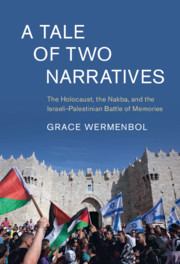Book contents
- A Tale of Two Narratives
- Cambridge Middle East Studies
- A Tale of Two Narratives
- Copyright page
- Dedication
- Epigraph
- Contents
- Figures
- Tables
- Acknowledgments
- A Note on Transliteration
- Abbreviations
- Introduction
- 1 The Post-Oslo Period
- Part I The Textbook of Memory
- Part II The Landscape of Memory
- 4 Recreating and Reclaiming the Lost Homeland
- 5 A Past That Does Not Pass
- Part III Scoop on the Past
- Conclusion
- Bibliography
- Index
- Series page
5 - A Past That Does Not Pass
from Part II - The Landscape of Memory
Published online by Cambridge University Press: 14 May 2021
- A Tale of Two Narratives
- Cambridge Middle East Studies
- A Tale of Two Narratives
- Copyright page
- Dedication
- Epigraph
- Contents
- Figures
- Tables
- Acknowledgments
- A Note on Transliteration
- Abbreviations
- Introduction
- 1 The Post-Oslo Period
- Part I The Textbook of Memory
- Part II The Landscape of Memory
- 4 Recreating and Reclaiming the Lost Homeland
- 5 A Past That Does Not Pass
- Part III Scoop on the Past
- Conclusion
- Bibliography
- Index
- Series page
Summary
Through a study of the most prominent Holocaust institutes in Israel – Yad Vashem, Lohamei Hagetaot, and Yad Mordechai – Chapter 5 demonstrates that Holocaust mnemonic rituals serve a defined political purpose, namely the justification of the need for a strong and independent Israeli state as the only viable way to hinder a recurrence of the Holocaust. The deliberate usage of teleological architecture at Yad Mordecai and Yad Vashem seeks to inspire a redemptive visitor experience through a regulated physical move from the exhibited darkness and catastrophe of Europe to the light and rebirth in Israel, the former destroyed; the latter victorious. The emphasis on a Jewish rebirth in the wake of the Holocaust in the institutes’ historical exhibits and in annual commemorative ceremonies prompts the merging of the dissonant categories of victim and victor, forming a metaphorical testimony to what Martin Jaffee described as “the victim-community” in which “the victim is always both victim and victor.” Beyond the overt minimization of the fate of non-Jewish victims and post-Holocaust diasporic Jewry, the Zionist panacea channeled at the memory sites demands a foregoing of the physical Palestinian history of the three sites themselves. As a result, visitors to the historic exhibits and participants in annual mnemonic rituals continue to take part in a cultural palimpsest as they are propelled to remember the physically superimposed Jewish watershed rather than the Nakba.
- Type
- Chapter
- Information
- A Tale of Two NarrativesThe Holocaust, the Nakba, and the Israeli-Palestinian Battle of Memories, pp. 191 - 224Publisher: Cambridge University PressPrint publication year: 2021

